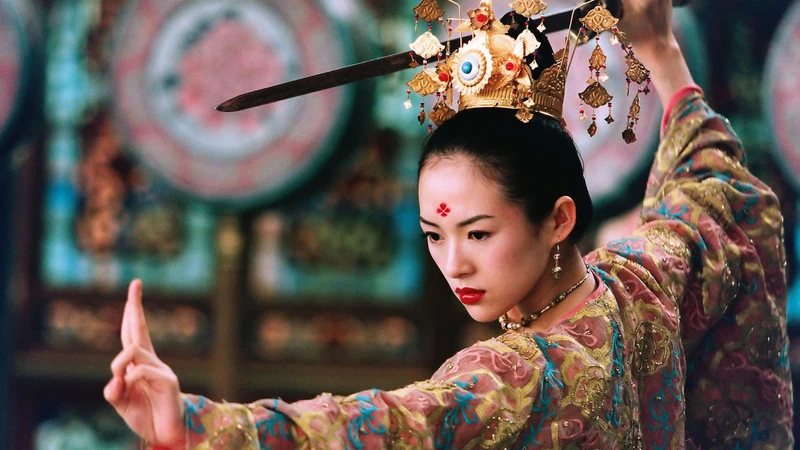House of Flying Daggers, directed by Zhang Yimou, is celebrated not only for its breathtaking visuals and poetic storytelling but also for its masterful action choreography. Among the film’s many iconic moments, the dummy scene stands out as a testament to the artistry and technical prowess of martial arts filmmaking. This scene has captivated audiences and critics alike, sparking curiosity about how such a seamless and dramatic stunt was orchestrated. In this article, we delve deep into the background, choreography, techniques, and significance of this legendary dummy scene, offering insights into its creation and impact.
Context of the Scene in the Film
House of Flying Daggers (2004) is a wuxia film set in the Tang Dynasty, blending romance, intrigue, and martial arts. The film’s narrative revolves around a love triangle involving a criminal, a rebel leader, and a police officer, all woven into a tapestry of deception and heroism. Visually stunning and emotionally charged, the film features numerous fight scenes that are as much about storytelling as they are about action.
The dummy scene appears in a pivotal moment where a character, often mistaken for being injured or incapacitated, is dramatically thrown or pushed into a stunt dummy. This scene is crucial because it exemplifies the film’s meticulous choreography and technical precision, often mistaken for real combat.
The Significance of the Dummy Scene
Why does the dummy scene hold such significance? Primarily, it showcases:
- Choreographic Excellence: The scene exemplifies the seamless integration of martial arts movements, camera work, and stunt coordination.
- Cinematic Impact: It heightens tension and emotion, often serving as a turning point for character development.
- Technical Mastery: The scene demonstrates advanced stunt techniques, safety measures, and practical effects, elevating the realism and intensity.
Understanding these aspects helps appreciate the scene beyond its visual spectacle, recognizing it as a masterpiece of cinematic craftsmanship.
Behind the Scenes: How Was the Dummy Scene Created?
Creating a scene like this involves a complex blend of choreography, stunt coordination, camera work, and post-production finesse. Here’s a breakdown of the typical process for such scenes in martial arts films, with insights specific to House of Flying Daggers:
1. Choreography and Planning
- Storyboard and Rehearsals: The scene is meticulously storyboarded, with choreographers designing every movement to ensure fluidity and safety.
- Fight Stunt Coordination: Skilled stunt coordinators choreograph the fight sequence, often collaborating with martial arts experts to achieve authentic movements.
2. Use of Dummy Props
- Designing the Dummy: The dummy is crafted to resemble a human figure, often made of lightweight materials like foam or rubber, with realistic facial features and body shape.
- Placement and Safety: It is secured carefully to avoid unintended movement or injury during stunts.
3. Stunt Execution
- Performing the Scene: Actors or stunt performers execute the sequence, often with multiple takes to perfect timing and positioning.
- Use of Wire Work: Wire-assisted movements may be employed to simulate jumps, flips, or falls, adding to the scene’s dynamism.
4. Camera Work and Angles
- Strategic Cinematography: Cinematographers select angles that conceal safety measures and emphasize action intensity.
- Slow Motion and Editing: Post-production techniques like slow motion accentuate key moments, making stunts appear more dramatic.
5. Post-Production Enhancements
- Visual Effects: Minor CGI or digital enhancements might be used to smooth out movements or add impact.
- Sound Design: Sound effects amplify the sense of action, making the scene more visceral.
Technical Aspects and Safety Measures
Executing a dummy scene safely yet convincingly requires meticulous planning:
- Material Selection: The dummy is made of durable but lightweight materials to withstand repeated impacts.
- Padding and Cushioning: Surrounding areas are padded to prevent injury during falls or collisions.
- Rehearsals: Multiple rehearsals ensure performers are familiar with timing, reducing risk.
- Stunt Coordination: Professional stunt coordinators oversee the shoot, ensuring all safety protocols are followed.
In House of Flying Daggers, the team’s emphasis on safety is evident in the precision and smoothness of the scene, which appears effortless yet is the result of rigorous preparation.
Artistic and Cinematic Techniques
The scene’s impact owes much to the artistic choices made by Zhang Yimou and his team:
- Dynamic Camera Angles: Close-ups, wide shots, and quick cuts create a sense of chaos and excitement.
- Lighting and Color: The use of contrasting colors and lighting enhances the visual drama.
- Sound and Music: The soundtrack complements the action, heightening emotional engagement.
These techniques work together to make the dummy scene not just a stunt but a storytelling device that advances the narrative.
Cultural and Cinematic Legacy
The dummy scene in House of Flying Daggers has left a lasting impression on martial arts cinema. It exemplifies how practical effects, when executed with skill and artistry, can create breathtaking visuals without over-reliance on CGI. It also highlights the importance of choreography, safety, and storytelling in action filmmaking.
Many filmmakers cite scenes like this as inspirations for their own work, emphasizing the value of craftsmanship and authenticity in martial arts films.
Conclusion
The dummy scene in House of Flying Daggers is a testament to the artistry, precision, and dedication of filmmakers and stunt performers. It captures the essence of martial arts cinema—combining technical prowess with storytelling to create moments that linger in the audience’s memory. Understanding the behind-the-scenes efforts reveals that such scenes are not just accidents of filmmaking but carefully crafted works of art, blending choreography, technology, and creativity.
As viewers, appreciating these scenes enriches our experience, allowing us to see beyond the spectacle and recognize the skill and effort that make cinematic magic possible. House of Flying Daggers continues to inspire filmmakers and martial arts enthusiasts alike, reminding us of the power of visual storytelling and the artistry behind every stunt.






